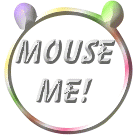onMouseOver Event

|
Type=banner Justify=left View=visible Rate=50 XGapAdj=0 IPath=images/ IExt=gif angAware=true |
Effect=pinwheel Direction=left Angle=0.0 Scale=1.0 YGapAdj=0 IPrefix=yamf Reverse=false YAMF OFF! |
When assigning a pixel value (px) to a positional element, Netscape 6 generates exception errors if the values are either very small or very large floating point numbers. Where this might occur is if one uses the JavaScript trigonometric functions to compute a position, i.e., Math.sin(), Math.cos(), etc. and then assigns the result directly to an element. To avoid these situations merely insure that any pixel values are converted to integer before assignment.
Following is a script scrap that demonstrates how to avoid this:
// Return element pointer
function getEPtr(ID) {
return isDOM2 ? document.getElementById(ID).style :
(isNS4 ? document.layers[ID] :
document.all[ID].style);
}
e = getEPtr(styleTagID);
coordX = Math.round(Math.sin(angle) * x);
coordY = Math.round(Math.cos(angle) * y);
if (isDOM2 || isIE4) {
e.left = coordX+"px";
e.top = coordY+"px";
} else {
e.left = coordX;
e.top = coordY;
} |
Inline Style Constraint on Internet Explorer 5
On Internet Explorer 5, defining a layer (<DIV id="myID">, <SPAN id="myID">) without including an inline style sheet reference for its position, style="left:xx;top:yy;", causes the DOM2 style sheet reference document.getElementById(id) method to fail. This problem did not exhibit itself using Netscape 6.
Since discovering this problem, Iíve upgraded to Internet Explorer 6 and discovered that this problem no longer exists, and since Microsoft doesnít allow more than one Internet Explorer version on a system, I was not able to reconfirm the existence of this problem when writing this article. Suffice it to say, itís probably a good idea to include a style sheet position reference if planning on reliably using the document.getElementById(id) method.
Must Use <LAYER> tag in Netscape 4 to perform DHTML
While Netscape 4 supports the use of both the <DIV> and <SPAN> tags for creating containers (layers), along with the inclusion of the inline style attribute for positioning, I was unable to get DHTML (moving elements) to work when using either of them. Either of these two methods is a standard way to create containers (layers) in both Netscape 6 and Internet Explorer 4/5/6. To make matters worse, every attempt to do so not only caused the browser to hang but also left a hidden Netscape 4 window running in the background (not even detectable via Windows Task Manager) that prevented Netscape 4 from restarting clean afterwards. After this occurred, the only way to restore Netscape 4 was to terminate the hidden Netscape 4 window using a system utility (not many people have these) or to restart Windows.
So, if you plan on creating DHTML using either <DIV> or <SPAN> tags, it is wise to test for the existence of Netscape 4 before attempting to manipulate their style sheet properties. If itís the client browser, either skip the DHTML manipulation or add Netscape 4-specific HTML tag, <LAYER>, and manipulate its style sheet properties.
| Previous | Next |
YAMF - "Yet Another Mouse Follower"
All Is Not What It Seems
Netscape 6 Made Me Do It!
Testing - To Reload or To Restart?
Browser Sniffing - Parse or Presence?
Avoiding JavaScript Errors on Earlier Browsers
Stopping Annoying Auto-Scroll in DOM2 Browsers
Netscape 6 is Pixel Picky
Inline Style Constraint on Internet Explorer 5
Must Use <LAYER> tag in Netscape 4 to perform DHTML
!DOCTYPE Compliance Mode
Take Care Not to Render in <HEAD> Section
Automatic Expansion of Relative URLs
The Elusive Netscape 4 Layer Elements
Temperamental onLoad After Reload
document.images[id].complete Property Dependency
Search Method Does Not Return Boolean Value
Regular Expression Global Flag Fails With Subsequent Usage
Conclusion
Resources
Downloads
Roll Your Own
onMouseOver Event

|
Type=banner Justify=right View=visible Rate=50 XGapAdj=0 IPath=images/ IExt=gif angAware=true |
Effect=pinwheel Direction=left Angle=0.0 Scale=1.0 YGapAdj=0 IPrefix=yamf Reverse=false YAMF OFF! |
onMouseOver Event

|
Type=banner Justify=center View=visible Rate=50 XGapAdj=0 IPath=images/ IExt=gif angAware=true |
Effect=pinwheel Direction=left Angle=0.0 Scale=1.0 YGapAdj=0 IPrefix=yamf Reverse=false YAMF OFF! |
onMouseOver Event

|
Type=banner Justify=right View=visible Rate=50 XGapAdj=0 IPath=images/ IExt=gif angAware=true |
Effect=pinwheel Direction=right Angle=0.0 Scale=1.0 YGapAdj=0 IPrefix=yamf Reverse=false YAMF OFF! |